Welcome to our guide on the care essentials for Japanese Maple Bonsai, scientifically known as Acer palmatum. This beautiful bonsai tree species is prized for its delicate leaves, vibrant colors, and unique branching patterns. Whether you’re a seasoned bonsai enthusiast or a beginner, understanding the essential care tips will help ensure the health and vitality of your Japanese Maple Bonsai.
Key Takeaways:
- Japanese Maple Bonsai, or Acer palmatum, is a popular bonsai tree species known for its delicate leaves and vibrant colors.
- Placement is crucial for the well-being of your Japanese Maple Bonsai. It thrives in sunny and airy locations but should be protected from direct sunlight when temperatures rise above 85°F (30°C).
- Proper watering is essential. Japanese Maple Bonsai requires daily watering during the growing season, with additional waterings on hotter days if the soil is well-drained.
- Pruning is necessary to maintain the shape and health of your Japanese Maple Bonsai. It can be done year-round, with specific techniques for different seasons.
Placement of Japanese Maple Bonsai


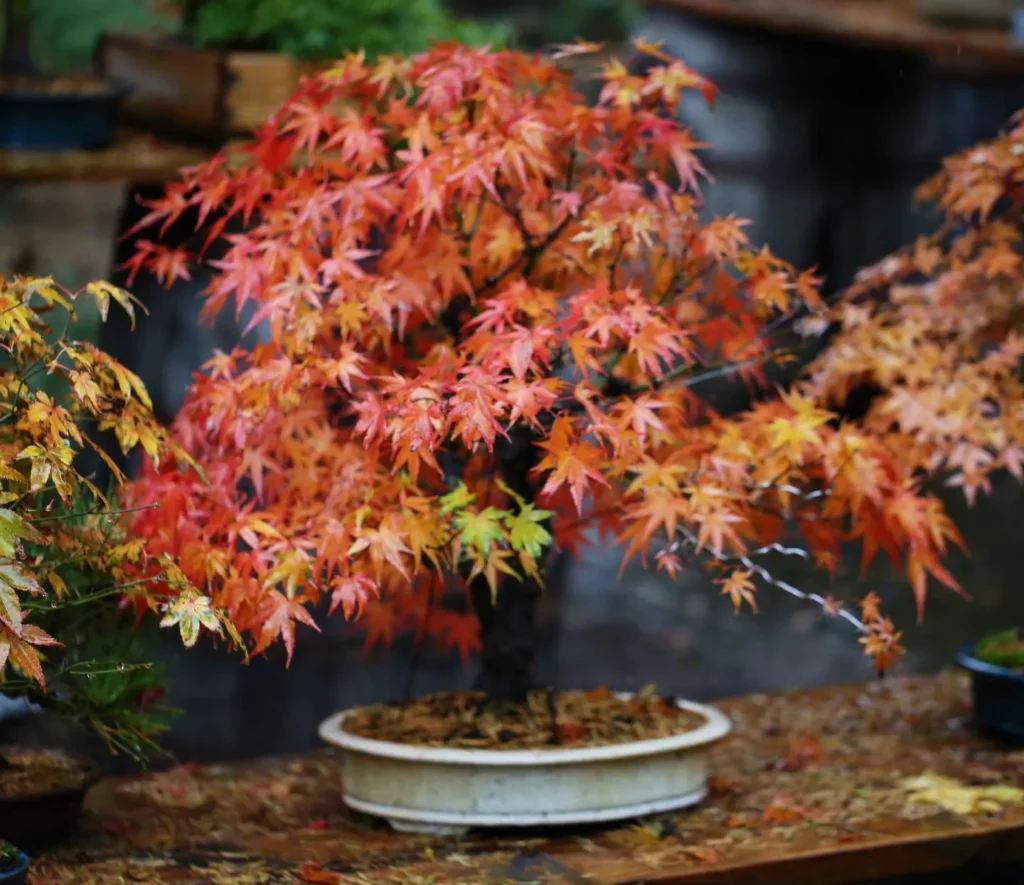
When it comes to the placement of your Japanese Maple Bonsai, it’s important to consider its specific light and temperature requirements. This beautiful bonsai species thrives in sunny and airy locations, where it can receive ample sunlight for healthy growth. However, it’s crucial to protect the bonsai from direct sunlight when temperatures rise above 85°F (30°C), as this can lead to leaf damage.
In colder climates, Japanese Maple Bonsai is frost hardy, but it still requires some protection when temperatures drop below 15°F (-10°C). Providing a sheltered spot or using insulation techniques can help safeguard the bonsai during harsh winters.
Overall, finding the right balance of sunlight and temperature is key to ensuring the well-being of your Japanese Maple Bonsai. By understanding and meeting its placement needs, you can create an optimal environment for this stunning bonsai tree to thrive.
Watering Japanese Maple Bonsai
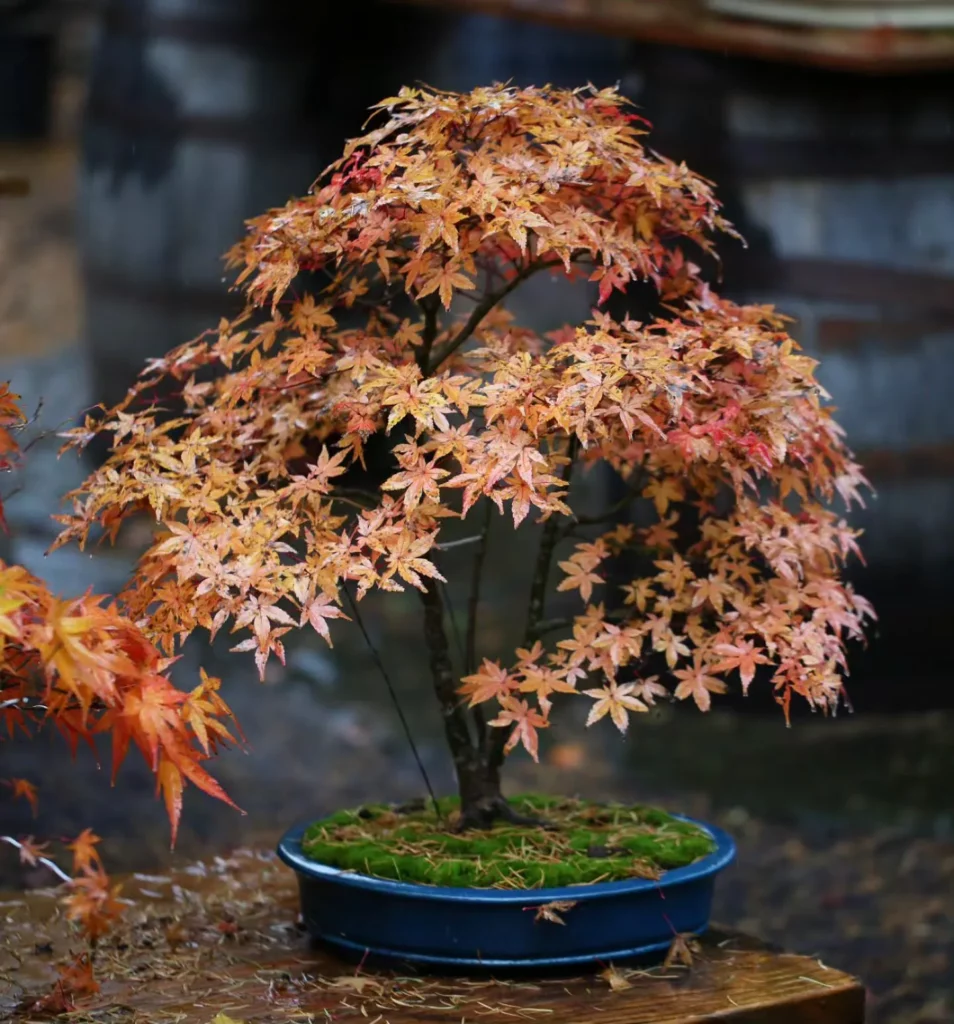
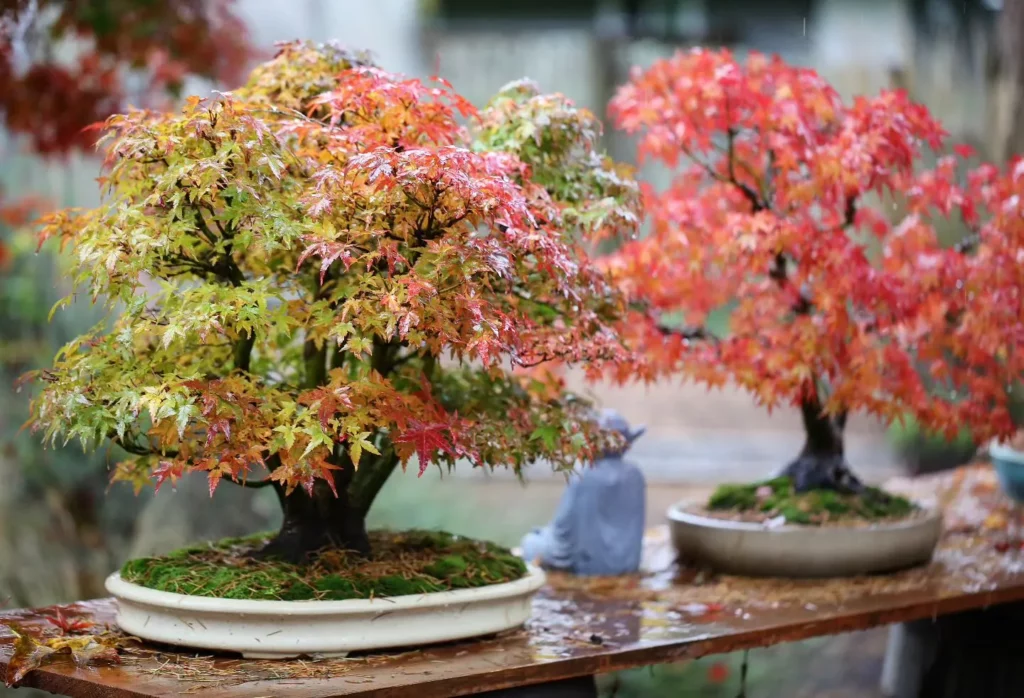
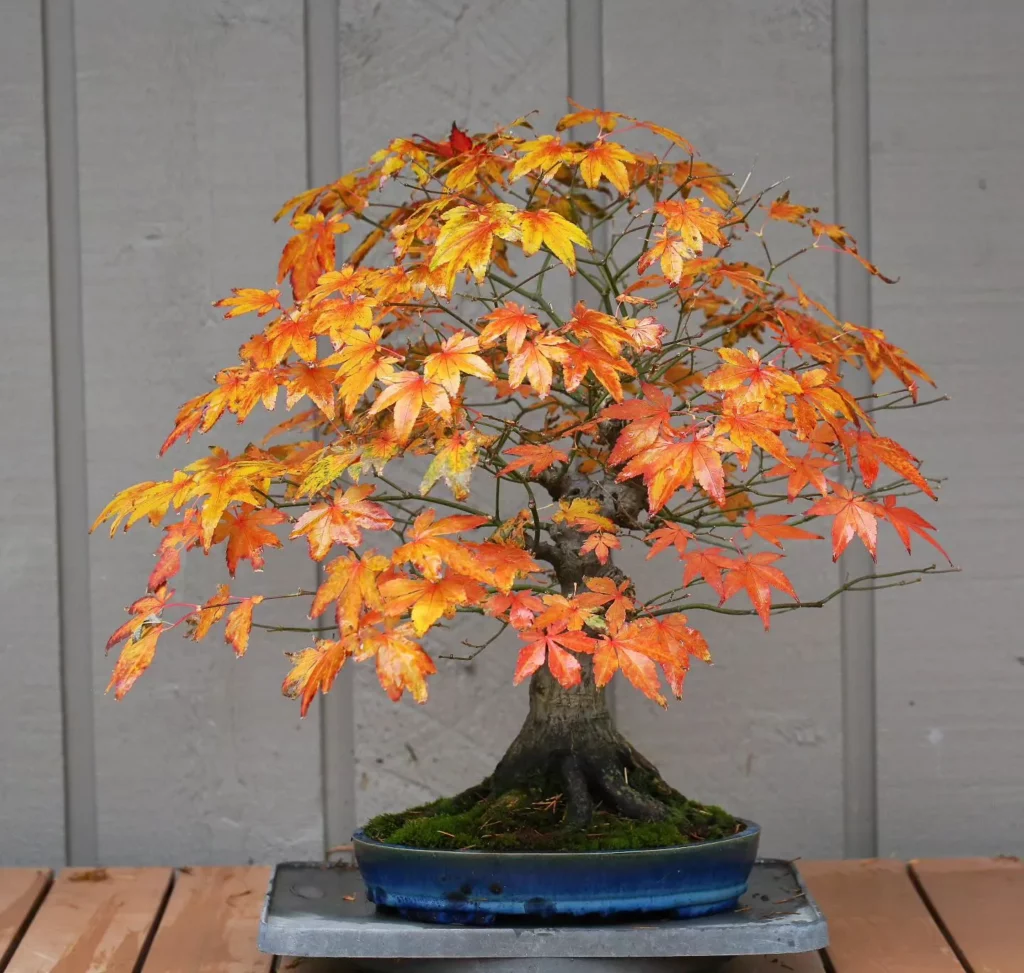
Proper watering is crucial for the health and vitality of your Japanese Maple Bonsai. Here are some essential tips to keep in mind:
- Frequency: Japanese Maple Bonsai typically requires daily watering during the growing season. However, the frequency may vary depending on factors such as temperature, humidity, and soil drainage. It’s important to check the soil moisture level before watering.
- Soil Moisture: The soil should be kept moist but not overly saturated. Aim for a balance where the soil is damp to the touch but not waterlogged. Regularly monitor the moisture level and adjust your watering routine accordingly.
- Well-Drained Soil: Japanese Maple Bonsai prefers well-drained soil to prevent waterlogging, which can lead to root rot. Ensure that the soil mixture used provides good drainage to allow excess water to escape.
- Water Quality: Japanese Maple Bonsai prefers neutral to slightly acidic pH water. If your tap water is too alkaline, consider using filtered or rainwater to ensure the optimal pH level for your bonsai.
- Leaf Spraying: In addition to regular watering, misting the leaves of your Japanese Maple Bonsai can help increase humidity levels and prevent excessive leaf drying. Use a fine mist sprayer to gently mist the foliage.
Signs of Underwatering and Overwatering
Monitoring the water needs of your Japanese Maple Bonsai is essential to avoid both underwatering and overwatering. Here are some signs to be aware of:
- Underwatering: Wilted leaves, dry soil, and a general lack of vigor are common signs of underwatering. If you notice these symptoms, increase the frequency of your watering and ensure that the soil is adequately moist.
- Overwatering: Yellowing leaves, root rot, and a stale smell coming from the soil are signs of overwatering. If you suspect overwatering, reduce the frequency of watering and allow the soil to dry out slightly between waterings.
Fertilizing Japanese Maple Bonsai

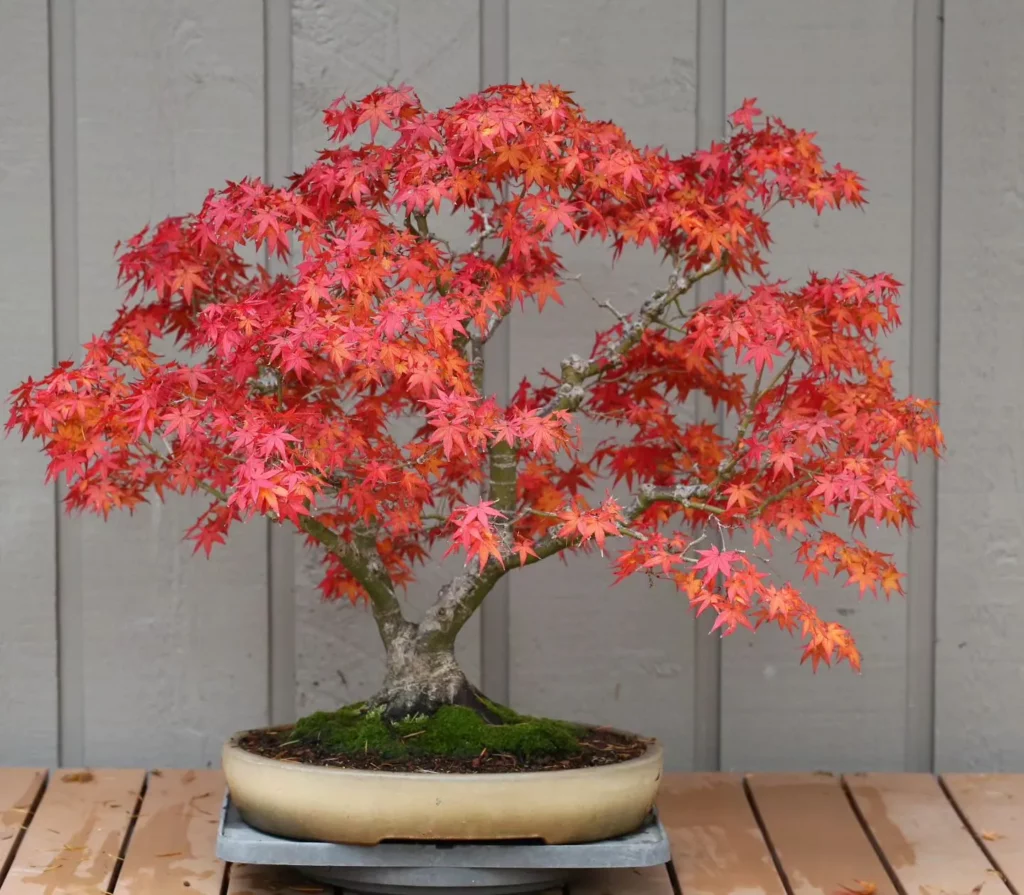

Fertilizing your Japanese Maple Bonsai is crucial for its growth and overall health. By providing the right nutrients, you can ensure that your bonsai tree thrives and displays its beautiful foliage to its fullest potential. Here are some essential guidelines to follow when fertilizing your Japanese Maple Bonsai:
- Choose the right fertilizer: Opt for solid, organic fertilizers that are specifically formulated for bonsai trees. These fertilizers contain essential micronutrients that promote healthy growth.
- Follow the instructions: Carefully read the instructions on the fertilizer packaging and follow the recommended dosage. Over-fertilizing can damage the roots and lead to leaf burn, so it’s important to use the correct amount.
- Avoid excessive nitrogen: While nitrogen is essential for growth, too much of it can result in excessive leaf and internode growth, creating an imbalanced and less aesthetic tree. Ensure that the nitrogen concentration in your fertilizer is appropriate for Japanese Maple Bonsai.
- Apply fertilizer during the growing season: Fertilize your Japanese Maple Bonsai during the active growing season, typically from spring to autumn. This is when the tree needs the most nutrients to support its growth and development.
- Use liquid fertilizers sparingly: Liquid fertilizers can be used to provide an extra boost of nutrients, especially for young plants or raw material. However, be cautious with high nitrogen concentration and use them sparingly.
Pruning Japanese Maple Bonsai
Pruning plays a crucial role in maintaining the health and shape of your Japanese Maple Bonsai. It helps promote proper growth, enhances the tree’s aesthetics, and encourages ramification. Here are some essential tips for pruning your Japanese Maple Bonsai:
1. Timing is key:
Pruning can be done throughout the year, but it is recommended to avoid heavy pruning during late autumn or winter when the tree is dormant. Pruning during these periods may lead to excessive sap bleeding and weaken the bonsai. Opt for pruning in early spring or summer to ensure the tree’s vitality and growth.
2. Branch selection:
When pruning branches, focus on removing any dead, damaged, or crossing branches. Select branches that contribute to the overall structure and balance of the bonsai. Be mindful not to remove too many branches at once, as it can stress the tree. Gradual pruning over time is preferred to maintain the health of your Japanese Maple Bonsai.
3. Leaf pruning:
Leaf pruning involves selectively removing leaves to promote better light penetration and encourage the growth of smaller, more refined leaves. However, it is important to avoid excessive leaf pruning every year, as it can put stress on the tree. Ideally, perform leaf pruning every two to three years to maintain a healthy balance between foliage and tree vigor.
Leaf Pruning Techniques for Japanese Maple Bonsai
Leaf pruning is an important technique in maintaining the health and aesthetic appeal of your Japanese Maple Bonsai. By selectively removing certain leaves, you can encourage new growth and enhance the overall balance of your bonsai tree.
Here are some essential leaf pruning techniques to help you achieve the desired results:
- Partial Leaf Pruning: This gentle method involves removing only specific leaves from your Japanese Maple Bonsai. Focus on removing the largest or closely spaced leaves, as well as leaves in strong areas of the tree. By doing so, you allow more light and airflow to reach the inner branches, promoting healthier growth.
- Timing: Leaf pruning can be done during the growing season, typically in late spring or early summer. Avoid pruning during periods of extreme heat or cold, as this can stress the tree. It’s important to note that full leaf pruning should not be done every year, as it can weaken the bonsai.
- Pruning Technique: When removing leaves, use sharp, clean bonsai scissors or shears to make clean cuts. Avoid tearing or damaging the surrounding foliage. Aim to prune back to one or two pairs of leaves on each branch. This encourages new growth and maintains the overall shape of the bonsai.
- Aftercare: After leaf pruning, monitor your Japanese Maple Bonsai closely for any signs of stress or nutrient deficiency. Provide adequate water, sunlight, and fertilization to support healthy recovery and growth. It’s also essential to protect the bonsai from harsh weather conditions to prevent further stress.
Repotting Japanese Maple Bonsai
Repotting is an essential task in the care of your Japanese Maple Bonsai. It not only provides the tree with fresh nutrients and promotes healthy growth but also allows you to monitor and manage the root system.
Here are some key points to remember when repotting your Japanese Maple Bonsai:
1. Repotting Frequency:
Japanese Maple Bonsai should be repotted every two years to prevent the roots from becoming pot-bound. Repotting allows the tree to develop a more compact root system and promotes the absorption of nutrients. However, it’s important to avoid repotting too frequently, as it can cause stress to the tree.
2. Timing:
The optimal time to repot your Japanese Maple Bonsai is during early spring, just before the buds start to swell. This timing allows the tree to recover quickly and take advantage of the upcoming growing season. Avoid repotting during hot summer months or during winter dormancy.
3. Soil Mixture:
Choosing the right soil mixture is crucial for the health of your Japanese Maple Bonsai. A well-drained soil mix that retains moisture while allowing excess water to drain is recommended. A popular mixture includes Akadama, Pumice, and lava rock in equal parts. This combination promotes root development and prevents waterlogging.
Propagation of Japanese Maple Bonsai
If you’re interested in expanding your collection of Japanese Maple Bonsai, propagation is a great option. There are several methods you can use to propagate this beautiful tree, including planting seeds, taking cuttings, and air layering.
Planting Seeds
One of the most common ways to propagate Japanese Maple Bonsai is by planting seeds. To increase the chances of successful germination, it’s recommended to stratify the seeds before sowing them. This involves placing the seeds in a moist paper towel and storing them in the refrigerator for a few weeks. Once stratified, you can sow the seeds in a seed tray filled with well-draining soil. Keep the soil consistently moist and provide indirect sunlight until the seedlings emerge.
Taking Cuttings
Another method of propagation is taking cuttings from an existing Japanese Maple Bonsai. Select a healthy branch and make a clean cut just below a node. Remove any leaves near the bottom of the cutting and dip the cut end in rooting hormone. Plant the cutting in a well-draining soil mixture and place it in a warm, humid environment. Mist the cutting regularly to maintain humidity and provide indirect sunlight. With proper care, the cutting will develop roots and grow into a new bonsai tree.
Air Layering
Air layering is a more advanced propagation method but can produce excellent results. Select a healthy branch and make a ring-shaped incision around the branch, removing the bark down to the cambium layer. Apply rooting hormone to the exposed cambium layer and wrap it with moist sphagnum moss. Cover the moss with plastic wrap to maintain moisture and secure it with tape. Over time, roots will form in the moss, and you can then remove the air layer and pot it separately to develop into a new Japanese Maple Bonsai.
Growth and Development of Japanese Maple Bonsai
Japanese Maple Bonsai, with its smooth trunk, plate-like nebari, and intricately ramified branches, has a unique growth pattern that contributes to its aesthetic appeal. To enhance the development and refinement of your Japanese Maple Bonsai, there are specific care practices to keep in mind.
1. Pruning Techniques
Pruning plays a crucial role in shaping the desired form of your bonsai. When pruning Japanese Maple Bonsai, it is important to remove excess growth and maintain the desired silhouette. Regular pruning helps to develop finer ramification and encourages the growth of smaller, more compact leaves.
2. Wiring and Styling
Wiring is often employed to guide the branches of Japanese Maple Bonsai into the desired positions. Care should be taken when wiring the delicate branches to avoid damage. Additionally, the styling of the bonsai should be considered, taking into account the natural growth patterns and aesthetic preferences.
3. Fertilization and Repotting
Proper fertilization is essential for the healthy growth and development of Japanese Maple Bonsai. Using a balanced organic fertilizer will provide the necessary nutrients for vibrant foliage and strong root development. Repotting every two years allows for root pruning and ensures the bonsai has enough space for growth.
Common Pests and Diseases of Japanese Maple Bonsai
While Japanese Maple Bonsai is generally a sturdy tree, it can sometimes face challenges in the form of pests and diseases. Being aware of these common issues will help you take preventive measures and ensure the health of your bonsai.
Pests:
- Aphids: These sap-sucking insects can infest your bonsai during spring. Keep an eye out for clusters of small, soft-bodied insects on the leaves and stems. Aphids can be controlled with standard insecticide sprays.
- Spider Mites: These tiny arachnids thrive in dry conditions and can cause discoloration and webbing on the leaves. Regular misting of the foliage and using insecticidal soaps can help prevent infestation.
- Caterpillars: Certain caterpillars are attracted to Japanese Maple Bonsai and can devour the leaves. Regular inspection and handpicking can help control their population.
Diseases:
- Verticillium Wilt: This fungal disease can cause partial or complete death of your bonsai. Look for wilting leaves, discoloration, and dieback. To prevent the spread of the disease, it is important to thoroughly clean and disinfect your tools after each use.
- Powdery Mildew: A common fungal infection that appears as a white or gray powdery coating on the leaves. Improving air circulation and reducing humidity levels can help prevent powdery mildew.
- Anthracnose: This fungal disease causes spots and lesions on the leaves and can lead to defoliation. Removing infected leaves and using fungicidal sprays can help control the spread of anthracnose.
The Natural Habitat of Japanese Maple Trees
Japanese Maple Trees, scientifically known as Acer palmatum, are native to Japan, China, and Korea. They are commonly found growing as shrub-like or slender trees in hilly areas. These beautiful trees have a distinctive appearance with their hand-shaped leaves that have multiple pointed lobes.
Japanese Maple Trees are renowned for their stunning autumn colors, which range from vibrant reds and oranges to deep purples and yellows. The changing foliage creates a breathtaking display that attracts admirers from around the world. This natural phenomenon has made Japanese Maple Trees a sought-after choice for bonsai enthusiasts.
When grown in their native habitat, Japanese Maple Trees can reach heights of up to 33 feet (10 meters). They thrive in temperate climates with well-drained soil and prefer partially shaded areas. In their natural environment, these trees provide shade and enhance the aesthetic appeal of gardens and landscapes.
With their captivating beauty and unique characteristics, it’s no wonder that Japanese Maple Trees have become a popular choice for bonsai enthusiasts who wish to recreate the elegance of these trees on a smaller scale. By understanding the natural habitat of Japanese Maple Trees, bonsai growers can better replicate the optimal conditions needed to care for their Japanese Maple Bonsai.
Japanese Maple Varieties for Bonsai Growing
When it comes to bonsai cultivation, Japanese Maple varieties offer a wide array of choices to suit your aesthetic preferences. These stunning cultivars, known for their vibrant colors and unique leaf shapes, can elevate the beauty of your bonsai collection. Let’s take a closer look at some popular Japanese Maple varieties perfect for bonsai growing.
Fireglow (Acer palmatum ‘Fireglow’)
With its fiery red leaves, the Fireglow Japanese Maple is a captivating choice for bonsai enthusiasts. This variety is known for its intense autumn foliage, creating a stunning display of vibrant reds. Its compact size and delicate branching patterns make it ideal for smaller bonsai designs.
Osakazuki (Acer palmatum ‘Osakazuki’)
The Osakazuki Japanese Maple is highly prized for its breathtaking fall colors, with leaves transitioning from vibrant green to a brilliant crimson. This variety showcases a dense and rounded canopy, making it a popular choice for creating the classic broom-style bonsai. Its sturdy branches make it suitable for shaping and wiring.
Lion’s Head (Acer palmatum ‘Shishigashira’)
If you prefer a more unique look for your bonsai, the Lion’s Head Japanese Maple is an excellent choice. This variety features densely clustered, crinkled foliage that resembles a lion’s mane. Its compact size and intricate branch structure make it a standout addition to any bonsai collection.
Coral Bark (Acer palmatum ‘Sango Kaku’)
The Coral Bark Japanese Maple is renowned for its stunning coral-colored bark, which becomes even more vibrant in the winter months. This variety’s striking contrast against its bright green foliage creates a visual spectacle. Its upright growth habit makes it an ideal candidate for formal upright or cascading bonsai styles.
FAQ
Can Japanese Maple Bonsai be placed in direct sunlight?
Japanese Maple Bonsai thrives in sunny locations but should be protected from direct sunlight when temperatures rise above 85°F (30°C) to prevent leaf damage.
How should I protect my Japanese Maple Bonsai from extreme temperatures?
Japanese Maple Bonsai is frost hardy but needs protection when temperatures drop below 15°F (-10°C).
How often should I water my Japanese Maple Bonsai?
Japanese Maple Bonsai requires daily watering during the growing season, with additional waterings on hotter days if the soil is well-drained. It is important to avoid overwatering or letting the soil dry out completely.
What type of water should I use to water my Japanese Maple Bonsai?
Japanese Maple Bonsai prefers neutral to slightly acidic pH water.
What type of fertilizer should I use for my Japanese Maple Bonsai?
Japanese Maple Bonsai benefits from solid, organic fertilizers that provide essential micronutrients. It is essential to follow instructions carefully for proper dosage. Liquid fertilizers can be used for stronger growth on young plants or raw material, but high nitrogen concentration should be avoided to prevent excessive leaf and internode growth.
When is the best time to prune my Japanese Maple Bonsai?
Pruning of Japanese Maple Bonsai can be done year-round. Autumn or summer pruning is recommended for strong branches to prevent bleeding. New growth should be pruned back to one or two pairs of leaves.
How often should I do leaf pruning on my Japanese Maple Bonsai?
Leaf pruning can be done during the growing season, but should not be done every year to avoid stress on the tree. Partial leaf pruning is a gentler method that can be done annually by removing the largest or closely spaced leaves or leaves in strong areas of the tree.
How often should I repot my Japanese Maple Bonsai?
Japanese Maple Bonsai should be repotted every two years to accommodate its quick-growing roots. Pruning of the roots is necessary during repotting. A well-drained soil mixture, such as Akadama mixed with Pumice and lava rock, should be used.
How can I propagate Japanese Maple Bonsai?
Japanese Maple Bonsai can be propagated through planting seeds, cuttings, or air layering during the summer. Each method has its own requirements and techniques for successful propagation.
What should I know about the growth and development of Japanese Maple Bonsai?
Japanese Maple Bonsai has a unique growth pattern with its smooth trunk, plate-like nebari, and intricately ramified branches. There are nuances in pruning, repotting, and fertilization that can enhance the tree’s development and refinement.
What are common pests and diseases of Japanese Maple Bonsai?
Japanese Maple Bonsai can be susceptible to sap-sucking insects such as aphids during spring. Aphids can be controlled with standard insecticide sprays. Verticillium wilt, a fungal disease, can cause partial or complete death of the bonsai. Thoroughly cleaning and disinfecting tools are important to prevent the spread of diseases.
Where are Japanese Maple Trees native to?
Japanese Maple Trees are native to Japan, China, and Korea. They are commonly found growing as shrub-like or slender trees in hilly areas.
What are some popular Japanese Maple varieties for bonsai growing?
There are numerous cultivars of Japanese Maple suitable for bonsai, each with its own leaf colors, shapes, and growth habits. Some popular varieties include Fireglow, Osakazuki, Lion’s Head, and Coral Bark Japanese Maple.




